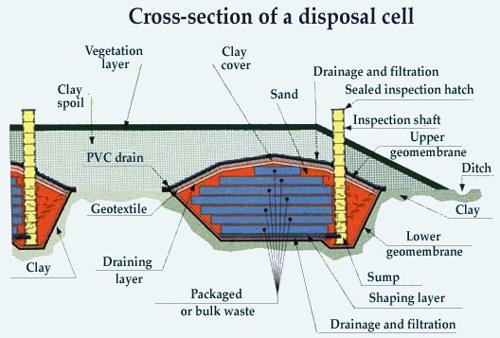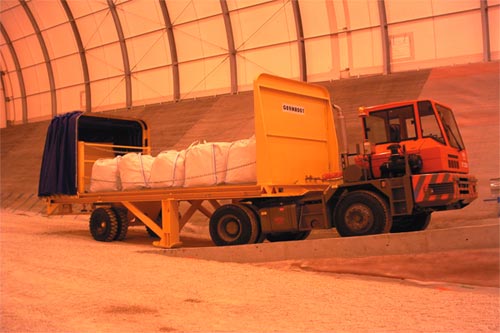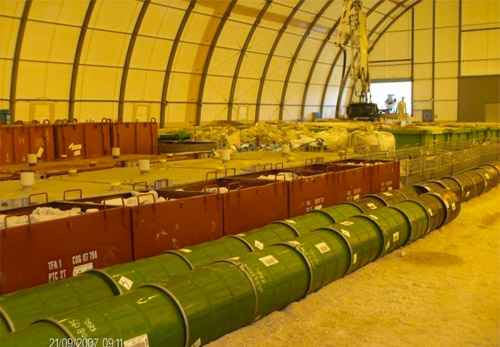An operational repository for very low-level waste
The second category of waste for which a repository now exists in France is very low-level waste (VLLW).
In August 2002, ANDRA opened a VLLW waste repository named CIRES (Centre Industiel de Regroupement, d’Entreposage et de Stockage). This disposal facility is located in Morvilliers, a straight-line distance of 2 km from the Aube repository (CSA), which handles low- and intermediate-level waste.

Cross-section of a « Very Low Level Waste » waste cell
This cross-sectional diagram of a repository cell shows the disposal concept implemented for very low-level waste. To prevent infiltration water from coming into contact with drums or boxes, the cell is isolated by means of plastic sheeting. The filled cell is covered with a thick layer of clay spoil.
© ANDRA
The new facility is designed to accommodate 650,000 cubic metres of waste. The first waste was delivered on 1 October 2003. In 2011, the waste inventory by volume stood at 360,000 m3, of which 203,000 m3 had already been disposed of at the Morvilliers repository. More than 30,000 cubic metres are disposed of there each year, and this figure is rising.
The principal sources of VLLW waste include nuclear installations, a few industries that use radioactive mineral ores, restoration work at previously contaminated sites, etc. Thanks to the CIRES facility in Morvilliers, some of the waste generated by dismantling operations can now also be disposed of at a special-purpose repository in France.
ANDRA video about CIRES, the VLLW waste repository in Morvilliers
Much of the waste consists of inert materials (concrete, rubble and earth) or non-hazardous industrial waste (structural steelwork, pipes and ventilation ducts). Their initial radioactivity levels generally lie in a range between 2 and 100 becquerels (Bq) per gram. Within a few decades, the average activity level decays to a few Bq/g, similar to that of natural rock such as granite.
Due to the low activity level, there is no need to take measures to immobilise radioactivity for the long-term. Very basic conditioning is sufficient. The main purpose of the conditioning is to prevent radioactivity from being dispersed by handling operations during disposal. For example, waste subject to a risk of dispersion is packaged in big bags.

Filling a VLLW disposal cell
This photo shows a truck loaded with big bags of waste (generally rubble) arriving at a disposal cell at the VLLW repository in Morvilliers. While a cell is in service, removable roofing is erected to provide shelter from water as waste is brought in.
© ANDRA
Approximately 30% of waste is compacted – to reduce its volume – or solidified, in the case of sludge, which is chemically stabilised and then mixed with a hydraulic binder.
After being conditioned, the waste – in the form of metal containers, big bags of rubble, metal drums and solid metal components – is placed into disposal cells excavated into the clay. An opening roof is erected over disposal cells while they are being filled, to protect against rain. The clay soil’s retaining properties ensure that any residual long-lived radioactive atoms will be durably contained. Water quality is monitored while the site is filled. This monitoring will continue during the subsequent monitoring period, pending the return to natural background radioactivity levels.

Growing requirements
The disposal cell geometry had to be changed in order to cope with predicted greater waste volumes (35,000 m3 per year). The ground at the repository has been excavated in order to accommodate the additional volume.
© ANDRA
The VLLW waste repository in Morvilliers is filling up more rapidly than originally planned. At the end of 2022, 451,259 m3 had been stored at CIRES, in the following proportions:
– 44 % metallic materials (from the dismantling of nuclear power plants, electric cables, etc.)
– 34 % inert minerals (concrete, rubble or earth)
– 11 % incinerable solid objects (cellulosic and plastic materials)
– 11 % miscellaneous (resins, settling sludge, wood, etc.)
Current predictions point to a volume of 1,300,000 m3 by 2030. This increase is partially attributable to the dismantling of decommissioned basic nuclear installations, such as the Grenoble Siloe and Melusine.
Several options for increasing waste disposal capacity are possible: expanding capacity at the facilities in Morvilliers; creating a new VLLW repository; and creating in situ repositories for certain waste at dismantled facilities. Certain VLLW waste could also be recycled or managed differently, for example, by compacting crushed rubble in VLLW disposal cells.
ANDRA video
ANDRA video To protect the planned disposal cells at the CIRES repository, ANDRA has developed the Prémorail opening roof, featuring a metal structure mounted on rails.
ALSO : Early waste disposal facilities
ALSO : Aube repository (CSA)
Other articles on the subject « Waste management »
Waste management status
Repositories already in operation for low-level waste Compared with other types of waste, the mas[...]
Other storage facilities
Interim waste storage according to their nature and origin Spent fuel and vitrified waste from Pr[...]
Temporary storage
A temporary solution Interim storage is a temporary solution that plays a central role in the man[...]
Vitrified waste Storage
Dry storage of vitrified waste Spent nuclear fuel assemblies are not the only materials removed f[...]
Spent fuel storage
Interim storage in pools and then dry locations In all countries, spent fuel management begins wi[...]
Management outside France
Overview of waste management strategies outside France Management of the least radioactive waste [...]
LILW-SL waste repository
Disposal of low and intermediate-level short-lived waste Low and intermediate-level short-lived w[...]
High level waste transportation
Moving highly radioactive materials The 10% of transport movements that concern high-level radioa[...]
Transport safety
Measures to ensure safe transport Nuclear materials may be highly radioactive. The goal is to pre[...]
Transport-related incidents
Incidents but no accidents… Have radioactive material transport operations caused any accid[...]